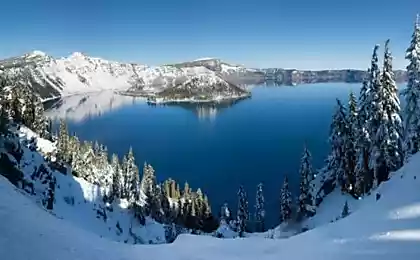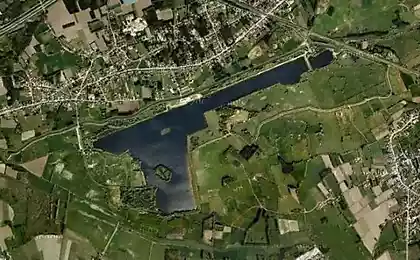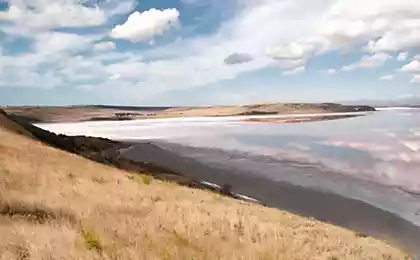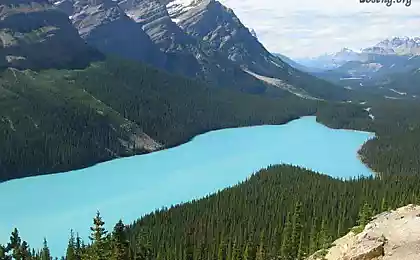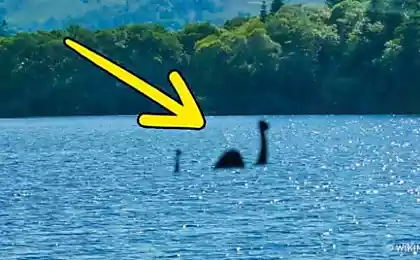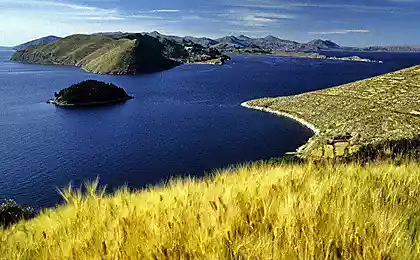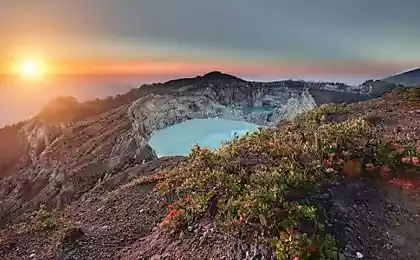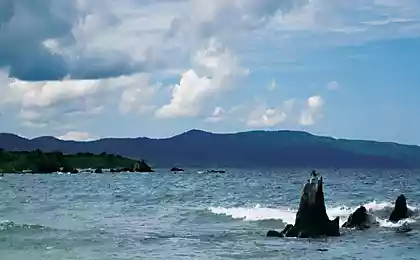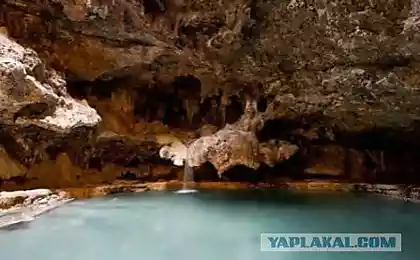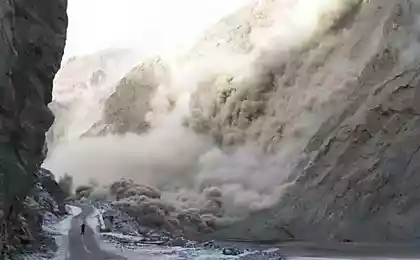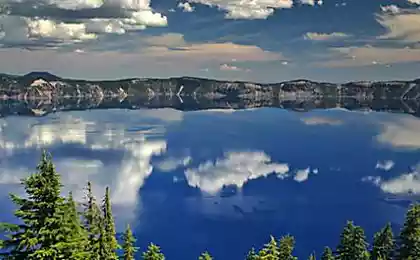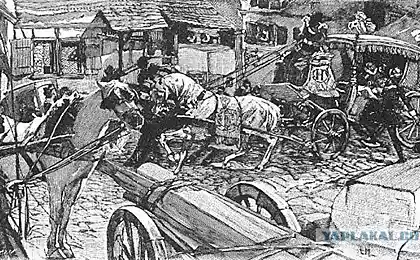793
Lake killer (4 photos)
Mohammed Abdullahi Musa woke up Saturday morning sick and sluggish. The day before he felt ill and lay directly in the school building. Abdullahi walked to the house and suddenly noticed that on the streets of his village in north-west Cameroon, frightening silence reigns. Roads and yards were littered with corpses Subuma. People were lying as if dead on the move or in the middle of a conversation with a neighbor. Killing all dogs, all the cattle, the trees fell dead birds and insects.
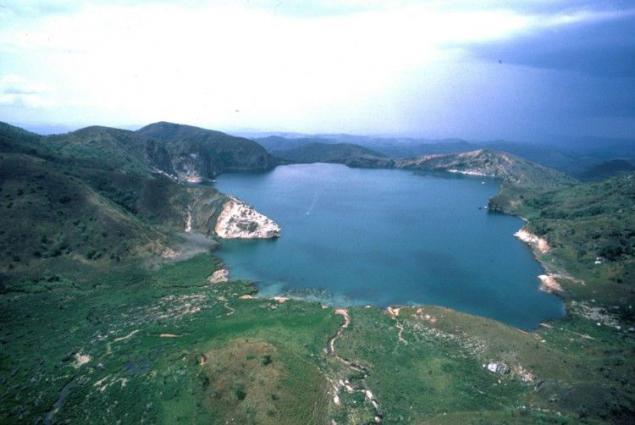
Since August 21, 1986 in the village on the shores of Lake Nyos killed 11 family members and another 1,700 Abdulahi his tribesmen. He survived because he was in a closed office, at school, built on a hill.
Lake before the disaster
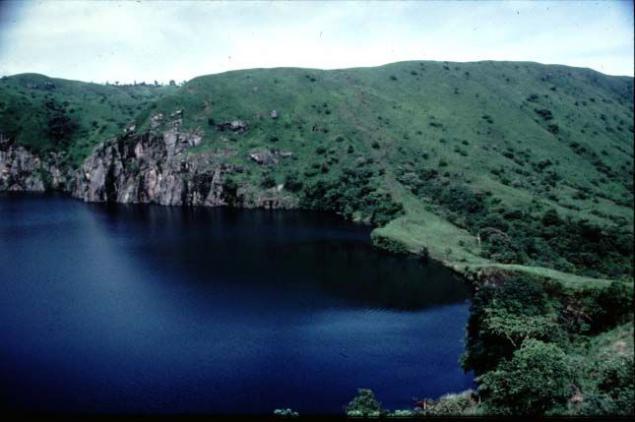
Lake after the disaster

Nyos - lake of great beauty - surrounded mostly cultivated fields, picturesque rocks and green hills. Pearl-gray surface serenely calm, but deep down there is an accumulation of explosive continuously forces. Nyos - is a crater was once an active volcano, which erupted after five centuries ago at the bottom left igneous plug. It has cooled down and compacted under a pressure of water. Such lakes around the world a lot, but only two are able to kill all life on their shores. The second lake - Monoun - is located 95 kilometers south-east of the RAT. And both of them are ready to explode.
As it was
Because of the deep volcanic activity, which is still ongoing, carbon dioxide is constantly being raised through the pores in igneous rocks. Meets the groundwater dissolves in them and with them falls into the lake. In the bottom layers of the lake accumulates a hell of a mixture that does not mix with the upper layers. Typically, a crater lake water periodically agitated, aerated waters rise to the surface, and gases without harming the natural environment are dispersed in the atmosphere. But in Nyos and Monoune boundary between the layers is not broken.
Gas continues to saturate the deeper layers of water until some external event will not disturb them. This can be a strong wind and excitement, unusually cold weather (when the upper layers of the water cool and sink to the depths), landslide or earthquake. Part of the deep water rises from the bottom, carbon dioxide is released from the solution and bubbles rushes up, pulling even more bottom water. By inertia process increases rapidly: a few bubbles turn into a stream of gas, and finally, as from an open bottle of champagne, sparkling water fountain strongly pulled up. In 1986, a RAT "fountain" beat to a height of 80 meters, and everything was drowned in a cloud of carbon dioxide.
Heavy and twice as heavy as air, gas down on the lake shore and choked all life in its path. When in August 1984 Lake Monoun exploded, killing 37 people. Lake Nyos longer and deeper, so it is able to carry out lethal force many more lives. The gas cloud is distributed around the neighborhood at a rate of more than 70 kilometers per hour and quickly gets even to the villages located 20 kilometers from the lake. The latter, who was killed by the explosion Nyos, a girl, the next morning after the eruption came down the hill to the valley filled with gas.
How will it be?
Lake Nyos necessarily explode again. According to the latest data, now in the lake twice as much carbon dioxide than it was during the previous explosion (0, 4 cubic kilometers now and only 0, 17 cubic kilometers in 1986). Disaster could destroy the fragile dam in the northern part of the lake, and then its water welling up in Nigeria, where flood the settlements of more than 10,000 people.
Despite the fact that after the disaster in 1986 3,500 people were evacuated from the shores of the lake and settled in safe areas, many are back - they are attracted by the fertility of the local land and rich vegetation. Corn fields in southern suited to the water, the hillsides grazing cattle, which was looked after by the Fulani herdsmen. Moreover, in the early 90s some European researchers released in bezrybnoe long to poison its inhabitants, tilapias lake - fish from the rocks Dupin. This experiment led to the fact that the fish are bred in large numbers, and the locals are not seriously taken a great interest in fishing.
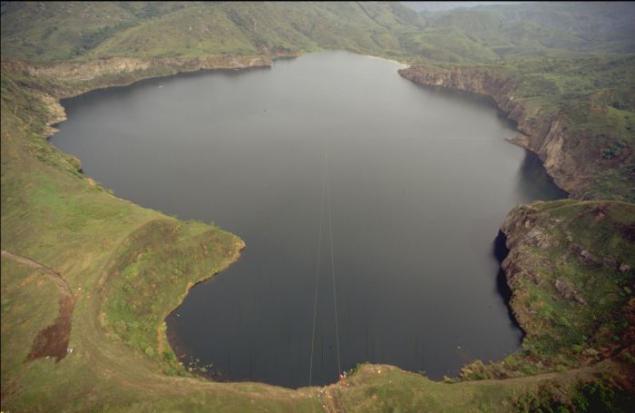
In 1999 he arrived in Cameroon international group of scientists to investigate the deadly lake and, if possible, find a way to save him from the poisonous gas accumulated in depth. But remoteness from major settlements complicates the task: to thoroughly examine and even more so to degas the lake can not be in a hurry. Although the project degassing exist, it does not have money. It did not help bring them even to UNESCO. After all charitable organizations accustomed to correct the effects of disasters that have already occurred, rather than prevent them.

Since August 21, 1986 in the village on the shores of Lake Nyos killed 11 family members and another 1,700 Abdulahi his tribesmen. He survived because he was in a closed office, at school, built on a hill.
Lake before the disaster

Lake after the disaster

Nyos - lake of great beauty - surrounded mostly cultivated fields, picturesque rocks and green hills. Pearl-gray surface serenely calm, but deep down there is an accumulation of explosive continuously forces. Nyos - is a crater was once an active volcano, which erupted after five centuries ago at the bottom left igneous plug. It has cooled down and compacted under a pressure of water. Such lakes around the world a lot, but only two are able to kill all life on their shores. The second lake - Monoun - is located 95 kilometers south-east of the RAT. And both of them are ready to explode.
As it was
Because of the deep volcanic activity, which is still ongoing, carbon dioxide is constantly being raised through the pores in igneous rocks. Meets the groundwater dissolves in them and with them falls into the lake. In the bottom layers of the lake accumulates a hell of a mixture that does not mix with the upper layers. Typically, a crater lake water periodically agitated, aerated waters rise to the surface, and gases without harming the natural environment are dispersed in the atmosphere. But in Nyos and Monoune boundary between the layers is not broken.
Gas continues to saturate the deeper layers of water until some external event will not disturb them. This can be a strong wind and excitement, unusually cold weather (when the upper layers of the water cool and sink to the depths), landslide or earthquake. Part of the deep water rises from the bottom, carbon dioxide is released from the solution and bubbles rushes up, pulling even more bottom water. By inertia process increases rapidly: a few bubbles turn into a stream of gas, and finally, as from an open bottle of champagne, sparkling water fountain strongly pulled up. In 1986, a RAT "fountain" beat to a height of 80 meters, and everything was drowned in a cloud of carbon dioxide.
Heavy and twice as heavy as air, gas down on the lake shore and choked all life in its path. When in August 1984 Lake Monoun exploded, killing 37 people. Lake Nyos longer and deeper, so it is able to carry out lethal force many more lives. The gas cloud is distributed around the neighborhood at a rate of more than 70 kilometers per hour and quickly gets even to the villages located 20 kilometers from the lake. The latter, who was killed by the explosion Nyos, a girl, the next morning after the eruption came down the hill to the valley filled with gas.
How will it be?
Lake Nyos necessarily explode again. According to the latest data, now in the lake twice as much carbon dioxide than it was during the previous explosion (0, 4 cubic kilometers now and only 0, 17 cubic kilometers in 1986). Disaster could destroy the fragile dam in the northern part of the lake, and then its water welling up in Nigeria, where flood the settlements of more than 10,000 people.
Despite the fact that after the disaster in 1986 3,500 people were evacuated from the shores of the lake and settled in safe areas, many are back - they are attracted by the fertility of the local land and rich vegetation. Corn fields in southern suited to the water, the hillsides grazing cattle, which was looked after by the Fulani herdsmen. Moreover, in the early 90s some European researchers released in bezrybnoe long to poison its inhabitants, tilapias lake - fish from the rocks Dupin. This experiment led to the fact that the fish are bred in large numbers, and the locals are not seriously taken a great interest in fishing.

In 1999 he arrived in Cameroon international group of scientists to investigate the deadly lake and, if possible, find a way to save him from the poisonous gas accumulated in depth. But remoteness from major settlements complicates the task: to thoroughly examine and even more so to degas the lake can not be in a hurry. Although the project degassing exist, it does not have money. It did not help bring them even to UNESCO. After all charitable organizations accustomed to correct the effects of disasters that have already occurred, rather than prevent them.
